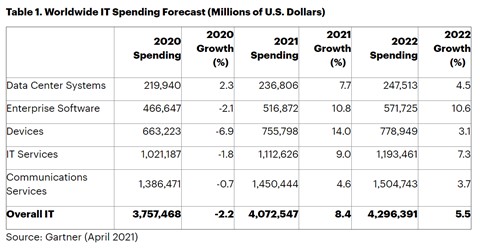It’s undeniable that one of the lasting impacts of the COVID-19 pandemic can be seen in essentially every area of business, both in the public and private sectors, and that is the warm embrace of the remote work environment and the technology that supports it. With IT spending on the rise, it is critical for VARs to understand the trends behind the available budgets so that they can support their customers’ business and IT objectives.
In a perfect example of the adage “money talks,” Gartner estimates that worldwide IT spending in 2021 will reach $4.07 trillion, exceeding the firm’s January estimate of $3.92 trillion, which indicates that there are no signs of slowing for businesses looking to build their IT infrastructure in order to support the new, more disparate reality of the workplace.
Some areas of notable growth according to Gartner’s report include data center systems, enterprise software, and IT services, as depicted in the data provided by Gartner below. These are all areas that align with the trend of a more permanent remote or hybrid work environment.

This shift signals to the IT channel that IT infrastructure is no longer merely a supporting means to an end for the success of a business but plays a starring role in a business’s value proposition. According to an article on CRN, John-David Lovelock, distinguished research vice president at Gartner, delved into this notion when reflecting on the results of this report.
“IT no longer just supports corporate operations as it traditionally has but is fully participating in business value delivery,” Lovelock said. “Not only does this shift IT from a back-office role to the front of business, but it also changes the source of funding from an overhead expense that is maintained, monitored and sometimes cut, to the thing that drives revenue.”
This mentality is key when considering the sales strategy for VARs and their customers’ primary business goals. With IT firmly in the foreground for many businesses, it’s essential for VARs to consider how a more comprehensive IT infrastructure for their customers is contributing to their value proposition as a whole, not simply how it’s helping employees perform their jobs day-to-day. This is especially germane in a world that operates in a more dispersed work environment and the resulting IT needs that come with that demand.
Author
-

The EDGE360 editorial team consists of Jackie Davis, Katherine Samiljan, and Jessica Nguyen. You can reach the team at EDGE360@gotostrategic.com.





